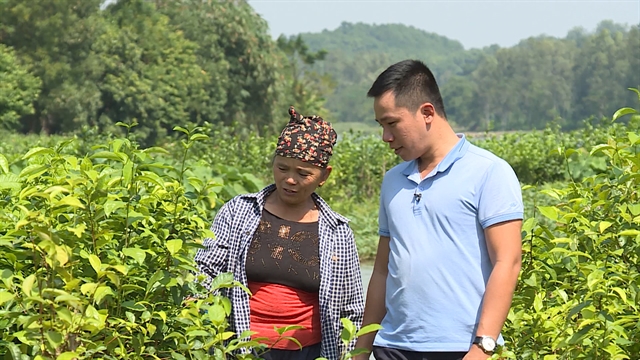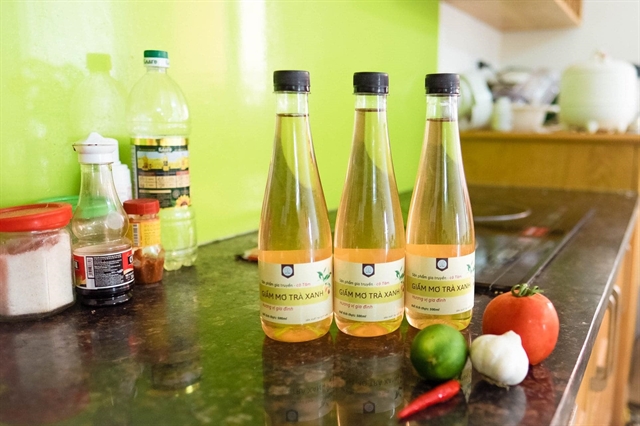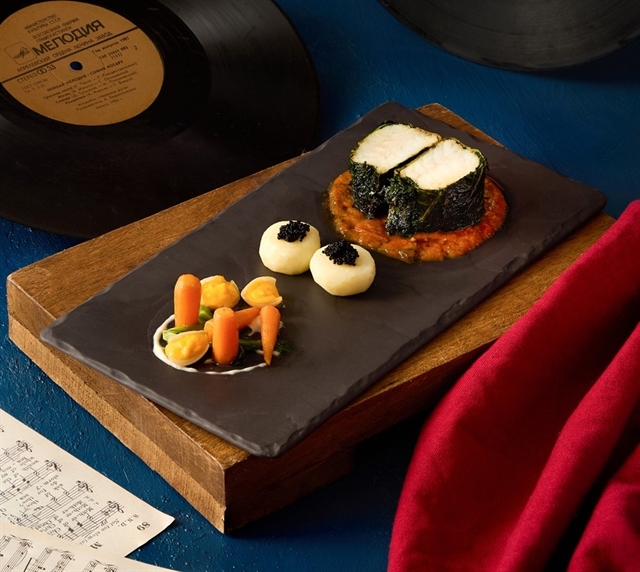 Sunday/Weekend
Sunday/Weekend

 |
| Vũ Minh Ngọc tests his vinegar that is made from his family's traditional secret. The green tea apricot vinegar has been known widely in his hometown in Nam Định Province and many other cities and provinces. Photo of danviet.vn |
Though he grew up in a home making artisanal vinegar, Vũ Minh Ngọc had never given it much thought. But he changed his mind when a woman customer told him his family's vinegar was the secret that had made her bún chả (grilled pork vermicelli) restaurant so popular.
"At first my mother makes vinegar mainly for our family, and later she spares a part to sell to some nearby restaurants. Since hearing about its popularity, I thought it was time to inherit my family business," said 32-year-old Ngọc.
In 2019, architect Ngọc quit his high salary job at a construction company in Hà Nội and returned to his hometown in Nam Định Province's Thành Lợi Commune, Vụ Bản District, to kick-start his plan.
"It is our Bách Cốc traditional craft that started in the early 20th century. Our villagers combined sweet pickled apricots with green tea liquid to make a recipe for fermented green tea apricot vinegar,” he said.
“In 1968, my grandfather Nguyễn Thanh Mai, former deputy general director of the Hà Nam Ninh Pharmacy Company, continued to research and perfect the fermentation formula.
"By 1995, his daughter Nguyễn Thị Minh Tâm -- my mother -- was passed on the entire recipe, including important ingredients and its special uses. The product was marketed on a small scale and is called Mrs Tâm's Vinegar by customers."
 |
| Vũ Minh Ngọc and his mother Nguyễn Thị Minh Tâm visit a green tea farm. The tea leaves are important ingredient in his vinegar making. Photo danviet.vn |
While vinegar is a popular cooking ingredient, it can also be used as a medicine, a preservative, and a drink to boost strength and promote wellness.
The habit of using vinegar in cooking has been maintained and consumer demand has increased over the years. A food company in Japan has introduced a drink made of rice vinegar in Việt Nam, which received great feedback from local consumers.
This helped Ngọc recognise the real potential of vinegar production, especially as the market for food ingredients and condiments continues to develop.
"Famous imported fruit vinegars such as American cider vinegar or Italian Balsamic grape vinegar dominate the market. Despite having a delicious unique taste, most of Việt Nam's artisanal vinegars suffer from inferiority on home turf," said Ngọc.
"Different from other kinds, green tea apricot vinegar offers a special taste that lifts the quality of the dishes. My vinegar is suitable for salads, dipping sauces, hot pots, and sour soups among others.
 |
| Vinegar is a popular ingredient in cooking and cleaning. It also can be used as a healthy drink. Photo courtesy of Vũ Minh Ngọc |
"In addition, it is a good probiotic-rich drink when mixed with honey that is wonderful for health and skincare, reducing heat, detoxifying, and stabilizing blood pressure," he said.
"I believe that if my product is safe for health and made with high quality at a reasonable price, it will find a place in any difficult markets."
He has decided to standardise his vinegar-making process to expand production. But running such a large production is not easy.
"In the original recipe, apricots are soaked in sugar for about three years, then mixed with green tea liquid to ferment. The tea will control the fermentation process slowly. Although it is delicious, it requires a lot of time. The product is highly appreciated, but I have lost many customers because we could not manage to have enough supplies," said Ngọc.
"When producing a large quantity, I was unable to control the quality of the product. In 2020, I had to throw away nearly 2,000 litres in four months due to its low quality. It was a big lesson, I will remember forever."
Ngọc spent time to read and ask for advice from experts and methods from Italy and Japan. He then adjusted his recipe with a suitable ratio of ingredients to find his own recipe to shorten the production time from six to three months.
In 2021, Ngọc's vinegar was awarded third prize at a Startup Project for Rural Young People, organised by the Central Committee of the Communist Youth Union.
 |
| In cooking, green tea apricot vinegar is used to make dipping sauce, salad and sour soup. |
Later, he was voted one of 57 outstanding young farmers nationwide who received the Lương Định Của Award, given to young people for achievements in manufacturing, trade, science and technology, environmental protection, and new rural lifestyles.
His vinegar can be found not only in many fresh food shops and restaurants in Nam Định, but also in Hà Nội and Hải Phòng as well as in Đà Nẵng and HCM City in the south.
"My vinegar is more expensive than the local ones, but still only around one-fifth of the imported ones. Its flavour persuades my customers who will pay to enjoy Vietnamese high-quality products," he said.
Last year, Ngọc established the Bách Cốc Youth Cooperative, which can produce up to 2,000 litres of vinegar per month.
It is expected to be a foundation for a vinegar-making village where locals can benefit from the traditional craft.
Ngọc has also begun to make other products from his vinegar.
“Currently, I am developing different kinds of dipping sauces for seafood, BBQ and salad, along with apricot jam and chilli and garlic vinegar. They are in the researching and testing phase. I need more time,” he said.
He expects his products to soon be tagged with geographical indication labels, making the green tea apricot vinegar a Bách Cốc trademark while publicising the history and culture of the village to a wider community. VNS




